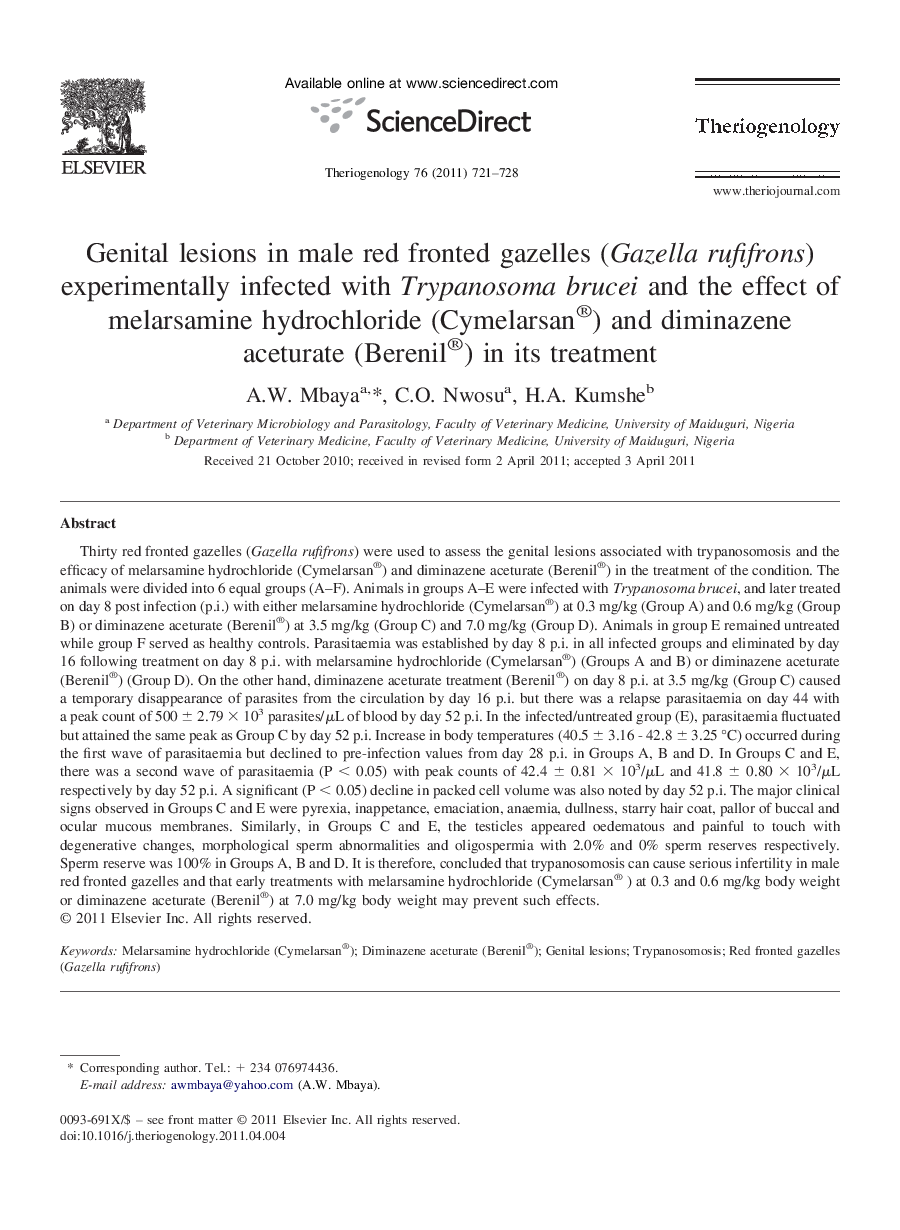| کد مقاله | کد نشریه | سال انتشار | مقاله انگلیسی | نسخه تمام متن |
|---|---|---|---|---|
| 10893026 | 1082136 | 2011 | 8 صفحه PDF | دانلود رایگان |
عنوان انگلیسی مقاله ISI
Genital lesions in male red fronted gazelles (Gazella rufifrons) experimentally infected with Trypanosoma brucei and the effect of melarsamine hydrochloride (Cymelarsan®) and diminazene aceturate (Berenil®) in its treatment
دانلود مقاله + سفارش ترجمه
دانلود مقاله ISI انگلیسی
رایگان برای ایرانیان
کلمات کلیدی
موضوعات مرتبط
علوم زیستی و بیوفناوری
علوم کشاورزی و بیولوژیک
علوم دامی و جانورشناسی
پیش نمایش صفحه اول مقاله

چکیده انگلیسی
Thirty red fronted gazelles (Gazella rufifrons) were used to assess the genital lesions associated with trypanosomosis and the efficacy of melarsamine hydrochloride (Cymelarsan®) and diminazene aceturate (Berenil®) in the treatment of the condition. The animals were divided into 6 equal groups (A-F). Animals in groups A-E were infected with Trypanosoma brucei, and later treated on day 8 post infection (p.i.) with either melarsamine hydrochloride (Cymelarsan®) at 0.3 mg/kg (Group A) and 0.6 mg/kg (Group B) or diminazene aceturate (Berenil®) at 3.5 mg/kg (Group C) and 7.0 mg/kg (Group D). Animals in group E remained untreated while group F served as healthy controls. Parasitaemia was established by day 8 p.i. in all infected groups and eliminated by day 16 following treatment on day 8 p.i. with melarsamine hydrochloride (Cymelarsan®) (Groups A and B) or diminazene aceturate (Berenil®) (Group D). On the other hand, diminazene aceturate treatment (Berenil®) on day 8 p.i. at 3.5 mg/kg (Group C) caused a temporary disappearance of parasites from the circulation by day 16 p.i. but there was a relapse parasitaemia on day 44 with a peak count of 500 ± 2.79 à 103 parasites/μL of blood by day 52 p.i. In the infected/untreated group (E), parasitaemia fluctuated but attained the same peak as Group C by day 52 p.i. Increase in body temperatures (40.5 ± 3.16 - 42.8 ± 3.25 °C) occurred during the first wave of parasitaemia but declined to pre-infection values from day 28 p.i. in Groups A, B and D. In Groups C and E, there was a second wave of parasitaemia (P < 0.05) with peak counts of 42.4 ± 0.81 à 103/μL and 41.8 ± 0.80 à 103/μL respectively by day 52 p.i. A significant (P < 0.05) decline in packed cell volume was also noted by day 52 p.i. The major clinical signs observed in Groups C and E were pyrexia, inappetance, emaciation, anaemia, dullness, starry hair coat, pallor of buccal and ocular mucous membranes. Similarly, in Groups C and E, the testicles appeared oedematous and painful to touch with degenerative changes, morphological sperm abnormalities and oligospermia with 2.0% and 0% sperm reserves respectively. Sperm reserve was 100% in Groups A, B and D. It is therefore, concluded that trypanosomosis can cause serious infertility in male red fronted gazelles and that early treatments with melarsamine hydrochloride (Cymelarsan®) at 0.3 and 0.6 mg/kg body weight or diminazene aceturate (Berenil®) at 7.0 mg/kg body weight may prevent such effects.
ناشر
Database: Elsevier - ScienceDirect (ساینس دایرکت)
Journal: Theriogenology - Volume 76, Issue 4, 1 September 2011, Pages 721-728
Journal: Theriogenology - Volume 76, Issue 4, 1 September 2011, Pages 721-728
نویسندگان
A.W. Mbaya, C.O. Nwosu, H.A. Kumshe,